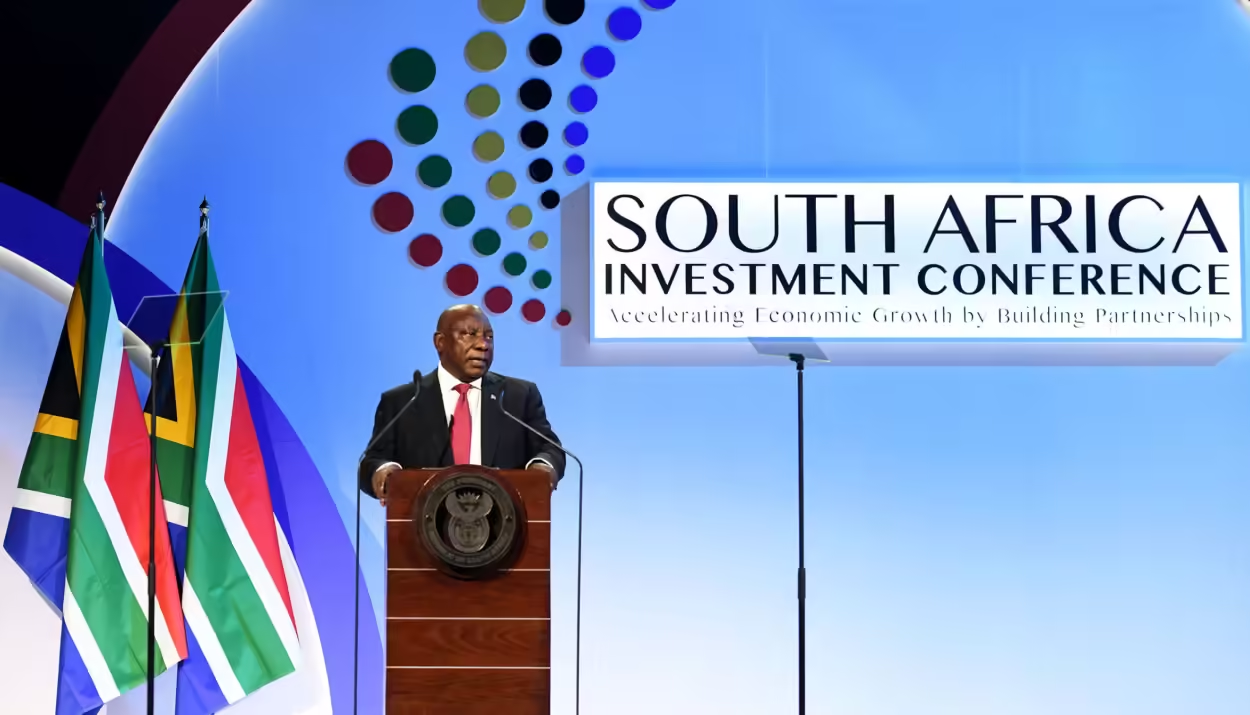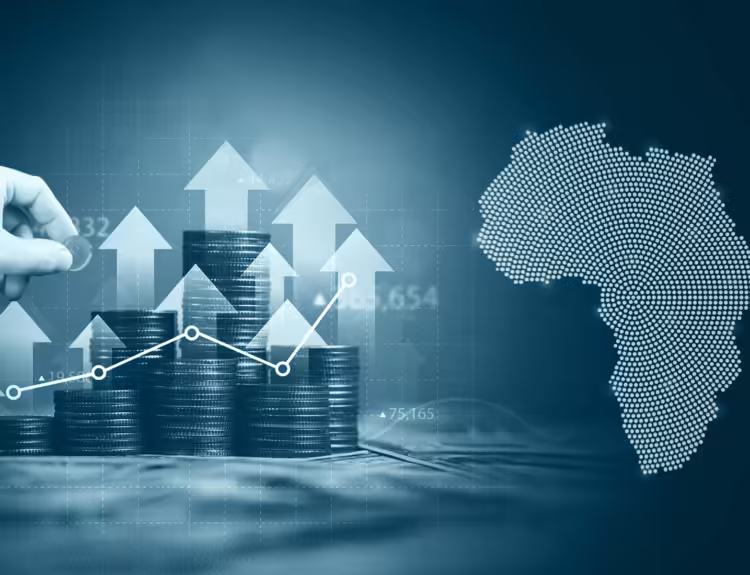Africa’s investment moment: When Italy’s oil major Eni said in April that it would pour roughly €24 billion ($26.2bn) into projects across Algeria, Libya, and Egypt over the next four years, the announcement read like a reprise of the continent’s fossil-fuel era. Yet where past headlines would have celebrated crude alone, the company’s plan — and many like it — now wear an ambivalent badge: hydrocarbon cash being reallocated into low-carbon upgrades, gas infrastructure, and technology to reduce emissions. The message is clear. In 2025, capital flows into Africa are increasingly cross-cutting: fossil fuels coexist with renewables, digital finance rubs shoulders with agritech, and foreign mining firms court governments that increasingly insist on local value-addition.
That ambivalence — investment that hedges between old and new economies — explains why investors, development banks, and governments speak in two tones. On one hand, international capital still prizes deposits that feed global supply chains: copper, cobalt, and lithium. On the other hand, there is the recognition that Africa’s long-term growth will be determined by the continent’s ability to electrify, digitise, and feed a population projected to grow sharply this century. The data point often used to frame that second task is striking: the International Energy Agency calculates that achieving Africa’s energy and climate goals through 2030 will require hundreds of billions of dollars annually — a scale that dwarfs current flows and exposes a yawning financing gap.
This is the context for 2025’s dealflow: some headline transactions and multibillion programmes; a far larger and messier world of mid-market project finance, venture rounds, and public-private partnerships; and a persistent question for investors — where to place long-term capital that respects political risk, currency volatility, and nascent regulatory regimes.
Renewables and the financing gulf
There is an obvious case for renewable energy in Africa. The continent has abundant solar, wind, and hydropower potential; electrification and reliable power are prerequisites for industrialisation and productivity gains. Yet the story is also a cautionary tale about scale. Multiple studies and regional reports show that while private investment into African renewables has risen sharply — to low tens of billions in recent years by some tallies — it still represents a sliver of what is required to meet demand and climate targets. TechCabal’s recent account notes a surge in renewables investment (estimating Africa’s renewable energy investment rising from $2.6bn in 2021 to around $40bn in 2024), but that figure is dwarfed by independent assessments of the funding need. The IEA’s analytics suggest annual needs measured in the tens to hundreds of billions for the continent to meet both energy access and climate commitments. The gap between what is being invested and what is required is the dominant investment story in 2025.
That gap creates both peril and promise. On the perilous side, projects that are bankable in Johannesburg or Cairo sometimes struggle to secure finance in smaller or higher-risk markets because of currency, contract, and governance risk. On the promising side, blended finance — mixes of concessional, private, and multilateral capital — has expanded. An uptick in investment vehicles linking pension funds, development finance institutions, and commercial banks aims to bridge early-stage risk. The result is a growing pipeline of mid-size utility-scale solar farms, off-grid mini-grids, and corporate offtake deals in East and West Africa. The burgeoning market for corporate renewable procurement (including trading platforms and power purchase agreements) is also helping firms hedge power costs — a business model attracting venture and project investors.
Notable deals and programmes in 2025 reflect this mixed reality. Large energy firms entertain both hydrocarbons and renewables in their portfolios (not least because reliable gas can complement intermittent solar investments). Public-private initiatives — often anchored by multilateral guarantees — are now the precondition for scaling projects past proof-of-concept. For long-term investors, the key metric has moved beyond IRR to include offtake security, local currency exposure, and the political durability of power purchase agreements.
FinTech, AI, and the continuing march of financial inclusion
FinTech is no longer a novelty — it is infrastructure. Digital payments, mobile money, and embedded finance remain the backbone of digital economies across Sub-Saharan Africa and North Africa. The sector’s prominence is underlined by regional venture capital data: FinTech secured US$1.4bn in 2024, according to Partech’s widely cited VC report, representing a dominant share of equity flows into African tech.
But beneath the headline is an evolution. First, investors are increasingly looking at profitability and unit economics rather than simply user growth. Market leaders that once chased scale now focus on product diversification: from payments into credit, savings, and insurance. Second, the AI wave is reworking the product stack. Startups are deploying machine learning to underwrite credit where formal financial history is limited, to automate customer service in local languages, and to detect payment fraud in real time. Third, incumbents and new entrants are leveraging partnerships: telcos, banks, and agents are bundling services that look less like single apps and more like financial stacks.
The effect is practical. In Kenya, Tanzania, and Nigeria, lenders are using alternative data (mobile usage, psychometric testing, e-commerce behaviour) to generate credit scores for previously unbanked populations. For investors, these products are attractive because they scale rapidly and improve portfolio risk by diversifying customer bases across geographies and product lines. Yet the challenge remains regulatory fragmentation — different data privacy laws, e-money rules, and KYC regimes complicate cross-border roll-outs.
Agriculture and agritech: the $1tn prize if value chains modernise
Agriculture is the continent’s largest employer and — numerically — its largest market. The African Development Bank and others have estimated that the continent’s food and agribusiness market could expand from about $280bn today to as much as $1tn by 2030 if productivity improves and value chains are modernised. That transformation would generate durable investment opportunities in upstream inputs (fertilisers, improved seeds), mid-stream logistics (cold-chains, storage), and downstream retail and processed foods.
AgriTech investments in 2025 reflect a two-pronged strategy. First, technologies that directly raise productivity — precision farming, satellite and drone analytics, soil sensors — are attracting capital because they can improve yields and reduce input costs. Second, the logistics and off-take layer — trucks, warehouses, last-mile refrigeration — is receiving interest because it reduces post-harvest loss and connects farmers to higher-value markets. Smart contracting platforms and commodity finance products are also emerging to de-risk seasonal revenue streams for smallholders.
From an investor’s standpoint, agritech’s attraction lies in defensibility and linkage to large domestic consumption markets. But it is capital-intensive and often requires long horizons, patient capital, and partnerships with government extension services. Where governments have made land-use and trade reforms, private investment has followed — especially in countries with stable macro frameworks and good port connectivity.
Health: local manufacturing and digital care
One of the most tangible policy shifts of the last few years is the push towards local pharmaceutical manufacturing. The pandemic exposed the vulnerability of supply chains for vaccines and generic medicines; the response has been to bring manufacturing capacity to the continent. BioNTech’s modular mRNA manufacturing facility in Kigali, launched as a pilot in 2022 and still scaling in 2025, is an emblematic example: it demonstrates the feasibility of local production and serves as a reference point for other countries looking to anchor pharmaceutical value chains domestically.
The rationale for local manufacturing is clear: reduce import dependence, create jobs, and improve resilience against global supply shocks. For investors, the value-creation case depends on government procurement commitments, regional regulatory harmonisation (which can open the entire African market), and local clinical and distribution capacity. Telemedicine and digital diagnostics, meanwhile, remain high on the venture agenda because they address chronic access gaps and often require lower capital intensity than manufacturing.
The mineral race: strategic resources, local value-add, and geopolitical jockeying
The electric vehicle revolution has transmuted African commodity profiles into strategic assets. Cobalt, lithium, nickel, and rare earths are now central to geopolitical industrial policy. African reserves — especially in the DRC, Zambia, and Zimbabwe — are attracting renewed attention because nations in Europe, Asia, and the Gulf are trying to secure supply chains for batteries and electronics.
The patterns in 2025 reveal two things. First, resource nationalism is on the rise: governments demand greater local processing, higher taxes, and equity stakes in major projects. Second, new players beyond traditional Chinese firms are moving into the space: Gulf sovereign funds and Western mining groups are writing bigger cheques, but they must now navigate tough local demands for beneficiation and the need for stable power and logistics. The result is longer deal timelines but potentially higher returns if investors commit to vertically integrated projects (mining plus refining plus battery assembly).
For private equity and infrastructure investors, this suggests a move away from “buy and ship” models toward investment into industrial corridors: power plants, rail links, and processing facilities that capture more of the commodity value chain on the continent.
Notable country stories and headline deals
A handful of country stories illustrate how the mix of politics, policy, and private capital plays out on the ground in 2025:
• North Africa and large energy incumbents. Eni’s multibillion-dollar plan to invest across Algeria, Libya, and Egypt signals persistent European interest in North African energy assets — but the emphasis on gas and cleaner technologies underscores the region’s role as both a fossil and transition hub.
• Uganda’s refinery pivot. Kampala’s agreement with the UAE’s Alpha MBM Investments for a refinery project in Kabaale — reported as part of a $4bn investment framework — highlights the continuing appetite for resource development but also the political stakes: infrastructure projects of this scale invariably reconfigure local labour markets, transport links, and regional trade. Construction activity is expected to intensify by late 2025.
• Bio-manufacturing in Rwanda. The BioNTech modular mRNA facility in Kigali is a concrete example of donors and private firms partnering to build local capacity — not just for emergency response but for supply-chain sovereignty and industrial policy.
These deals matter not only for their headline value but also for the example they set: they reveal what a coordinated public-private approach looks like and what investors can expect in terms of timeline, returns, and political engagement.
ALSO READ: Smart ways for young Africans to build wealth early
The role of development finance and blended instruments
If 2025’s most pressing challenge is a financing gap measured in tens or hundreds of billions, then the role of development finance institutions (DFIs) has never been clearer. DFIs and multilateral banks are increasingly combining concessional capital with private finance to derisk projects — especially in renewables, infrastructure, and social sectors. The challenge is to scale that approach without encouraging moral hazard or crowding out private capital. In practice, successful blended deals hinge on credible offtake contracts, realistic project timetables, and local partners who can manage execution risk.
For institutional investors — pension funds, insurance pools, sovereign wealth funds — the pathway to Africa is increasingly through pooled vehicles and guarantees that shield capital from foreign-exchange swings and political interventions. Where sovereign or multilateral credit support is absent, projects often fail to reach financial close.
Regulation, governance, and the political variable
Across sectors, the single most important non-financial input for investment outcomes is governance. African governments are not passive recipients of capital; many are becoming active negotiators, seeking local jobs, technology transfer, and refining capacity. Some are also contesting international credit metrics that they say overestimate risk and thus inflate borrowing costs. The continent’s heterogeneity means investors must be granular: the governance checklist for South Africa differs from that of Ghana, Kenya, or the DRC.
Political stability, transparency in procurement, and clarity in resource sharing are all decisive. Investors who have succeeded in recent years — whether in renewables, telecoms, or manufacturing — have typically combined deep local partnerships with patient capital and a readiness to work with public agencies to build viable regulatory frameworks.
Risks and the investor’s pragmatic checklist
For an investor in 2025, Africa presents a menu of opportunities that must be weighed against specific, addressable risks:
- Currency and macro risk. Projects earning local revenue are exposed to depreciation and capital repatriation costs. Hedging tools exist but are costly in some markets.
- Political and contract risk. Changes in government or policy can reprice projects overnight; long-term stability is worth a premium.
- Execution and logistics risk. Infrastructure gaps (roads, grids, ports) can add months and millions to project budgets.
- Regulatory fragmentation. Cross-border roll-outs face different licensing regimes and data and consumer-protection laws.
- Environmental and social licence. Community relations and traceability (especially in mining and agribusiness) are central to project sustainability.
Mitigating these risks commonly involves blended finance, conservative leverage, local partnerships, and realistic timelines. Institutional investors increasingly insist on pre-investment political risk insurance and multilateral guarantees for larger plays.
Where the smart money is looking in 2025
Given the risk-return tradeoffs, there are a few “sweet spots” where capital is clustering this year:
- Utility-scale renewables with creditworthy offtakers. Projects selling power to corporates or financially stronger utilities (often with DFI guarantees) are getting bankable terms.
- Payment rails and embedding finance in high-transaction sectors. FinTech firms that combine payments with credit and insurance for SMEs are scaling unit economics.
- Agri value-chain infrastructure. Cold-chain logistics and warehouse finance are attractive where port access and agronomic productivity create a ready market.
- Downstream minerals projects. Integrated mining projects that include refining and initial manufacturing attract higher multiples if electricity and transport are secured.
- Health manufacturing hubs. Where governments commit to procurement and regional harmonisation, local pharmaceutical plants move from developmental novelty to commercially viable assets.
A market of winners
Africa in 2025 is neither a single market nor a uniform risk. It is a polyglot of opportunities that reward patient capital, domain expertise, and a willingness to partner with government and development institutions. The headlines — big oil commitments in North Africa, a $4bn refinery project in Uganda, the expansion of local mRNA capacity in Rwanda — matter because they signal that both private and public actors are willing to make long bets. Yet the underlying story is the financing gap: the continent needs dramatically more capital than is currently flowing, and the form that capital takes — concessional vs commercial, equity vs debt, local currency vs hard currency — will determine whether projects merely launch or actually transform economies.
For investors, success in 2025 and beyond will look less like speculative land-grabs and more like carefully underwritten ecosystem plays: build the grid, secure the offtake, finance the processing plant, digitise the last mile. That is where Africa’s future cashflows — and returns — are most likely to be delivered.






